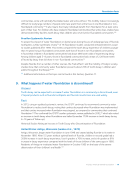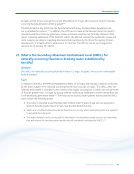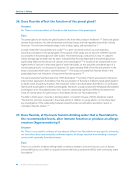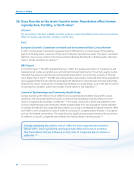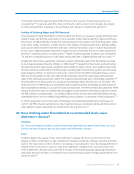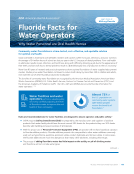© 2025 American Dental Association l 63
Fluoridation Facts
it is difficult to accept that there’s a risk for just a single age group and not for others. Further, as this
was an exploratory analysis excluding cases over age 20 and adjusting fluoride levels based on climate,
it is likely that fluoride exposure estimates were inaccurate, and it is possible that these findings were
impacted by these methodological decisions. Later, in 2020, a similar analysis was completed on
the larger case control study, which found no association between osteosarcoma and residence in a
fluoridated community or ingestion of topical or supplemental fluoride.194
A completely different type of analysis was published in 2011, finding no significant association between
the fluoride levels in bone and osteosarcoma risk.195 The study analyzed fluoride levels in bone samples
from 137 patients with primary osteosarcoma and bone samples from 51 patients with other newly
diagnosed malignant bone tumors who served as a control group. The vast majority of fluoride in
the body is located in calcified tissue such as bone. The study hypothesized that if chronic exposure
to fluoride was a risk factor for osteosarcoma, those cases would have a significantly higher level of
fluoride in bone than the controls. This was not the case. The major advantage of this study was the
ability to use actual bone fluoride levels as a measure of fluoride intake rather than estimating fluoride
exposure. Both the 2011 and 2020 papers had data analysis independently verified by independent
researchers and biostatisticians at the University of North Carolina at Chapel Hill.
The best available scientific evidence shows that fluoridated water does not cause osteosarcoma.
34. Does fluoride, as provided by community water fluoridation,
inhibit the activity of enzymes in humans?
Answer
No. The best available scientific evidence demonstrates that the recommended levels of fluoride
in drinking water have no effect on human enzyme activity.
Fact
Enzymes are organic compounds that promote chemical change in the body. The best available
scientific evidence has not indicated that water fluoridated at the recommended levels has any
influence on human enzyme activity. There are no available data to indicate that in humans drinking
water fluoridated at the recommended levels, the fluoride affects enzyme activities with toxic
consequences.297 The WHO report Fluorides and Human Health states, “No evidence has yet been
provided that fluoride ingested at 1 ppm in the drinking water affects intermediary metabolism of
food stuffs, vitamin utilization, or either hormonal or enzymatic activity.”298
In 2006, the NRC report stated that the available data were not sufficient to draw any conclusions
about potential effects or risks to liver enzymes from low-level, long-term fluoride exposures such
as those seen with community water fluoridation.26
The concentrations of fluoride used in laboratory studies to produce significant inhibition of enzymes
are hundreds of times greater than the concentration present in body fluids or tissues.299 While fluoride
could affect enzymes in an artificial environment outside a living organism in the laboratory, it is
unlikely that adequate cellular levels of fluoride to adversely alter enzyme activities would be attainable
in a living organism. The two primary physiological mechanisms that maintain a low concentration of
fluoride ion in body fluids are the rapid excretion of fluoride by the kidneys and the uptake of fluoride
by calcified tissues.211
Fluoridation Facts
it is difficult to accept that there’s a risk for just a single age group and not for others. Further, as this
was an exploratory analysis excluding cases over age 20 and adjusting fluoride levels based on climate,
it is likely that fluoride exposure estimates were inaccurate, and it is possible that these findings were
impacted by these methodological decisions. Later, in 2020, a similar analysis was completed on
the larger case control study, which found no association between osteosarcoma and residence in a
fluoridated community or ingestion of topical or supplemental fluoride.194
A completely different type of analysis was published in 2011, finding no significant association between
the fluoride levels in bone and osteosarcoma risk.195 The study analyzed fluoride levels in bone samples
from 137 patients with primary osteosarcoma and bone samples from 51 patients with other newly
diagnosed malignant bone tumors who served as a control group. The vast majority of fluoride in
the body is located in calcified tissue such as bone. The study hypothesized that if chronic exposure
to fluoride was a risk factor for osteosarcoma, those cases would have a significantly higher level of
fluoride in bone than the controls. This was not the case. The major advantage of this study was the
ability to use actual bone fluoride levels as a measure of fluoride intake rather than estimating fluoride
exposure. Both the 2011 and 2020 papers had data analysis independently verified by independent
researchers and biostatisticians at the University of North Carolina at Chapel Hill.
The best available scientific evidence shows that fluoridated water does not cause osteosarcoma.
34. Does fluoride, as provided by community water fluoridation,
inhibit the activity of enzymes in humans?
Answer
No. The best available scientific evidence demonstrates that the recommended levels of fluoride
in drinking water have no effect on human enzyme activity.
Fact
Enzymes are organic compounds that promote chemical change in the body. The best available
scientific evidence has not indicated that water fluoridated at the recommended levels has any
influence on human enzyme activity. There are no available data to indicate that in humans drinking
water fluoridated at the recommended levels, the fluoride affects enzyme activities with toxic
consequences.297 The WHO report Fluorides and Human Health states, “No evidence has yet been
provided that fluoride ingested at 1 ppm in the drinking water affects intermediary metabolism of
food stuffs, vitamin utilization, or either hormonal or enzymatic activity.”298
In 2006, the NRC report stated that the available data were not sufficient to draw any conclusions
about potential effects or risks to liver enzymes from low-level, long-term fluoride exposures such
as those seen with community water fluoridation.26
The concentrations of fluoride used in laboratory studies to produce significant inhibition of enzymes
are hundreds of times greater than the concentration present in body fluids or tissues.299 While fluoride
could affect enzymes in an artificial environment outside a living organism in the laboratory, it is
unlikely that adequate cellular levels of fluoride to adversely alter enzyme activities would be attainable
in a living organism. The two primary physiological mechanisms that maintain a low concentration of
fluoride ion in body fluids are the rapid excretion of fluoride by the kidneys and the uptake of fluoride
by calcified tissues.211





























